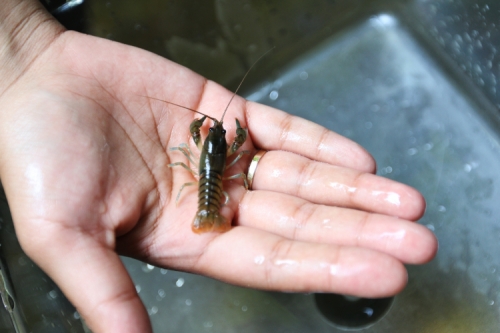It is a sticky, humid Tuesday morning in July. While many teenagers are just starting to roll out of bed, the high school students I’m with are unloading equipment from a van as they prepare to do some water testing at New Hope Creek in Durham. They are planning to conduct tests on the chemical and biological composition of the water, as well as examine how the water shapes rock formations.
This is a typical morning for participants of the Increasing Diversity and Enhancing Academia (IDEA) High School Program, a portion of UNC’s Environmental Resource Program, for local high school students interested in the geosciences. During the week-long institute, students attend classes, conduct experiments, meet seasoned scientists, and take daily field trips. They also attend three half-day Saturday academies during the school year. This year’s institute is focused primarily on the environmental challenges in Ellerbe Creek, one of Durham’s urban watersheds.
Lara Summers, a rising senior at Northwood High School, says that she first heard about the program from her AVID college preparatory teacher. “I am a bit of a science nerd, and I love the outdoors,” Summers says. “I felt that the program would be a fun and productive way to spend part of my summer break.” Summers, who hopes to pursue a science major in college, says that she loves the outdoor hands-on activities that the students do in the program.
Many students are never exposed to geosciences, says program leader Kathleen Gray. According to research from the National Science Foundation, specific groups that are underrepresented in the sciences as a whole are even less well represented in geosciences. Gray says that the IDEA program is a great way to combat both of these issues while engaging passionate students each year. Working with a network of science teachers and science curriculum specialists, the IDEA program reaches out to students across the Triangle area.
“The main goals of the program are to expose all students to geosciences in hopes that they will pursue graduate degrees and careers in the area, and to encourage underrepresented groups, including African Americans, Native Americans, Hispanics, and those with physical disabilities, to enter the science field,” Gray says.
In addition to the high school program, the grant also funds undergraduate interns that work during the school year and the summer. Since the start of the program, 85 high school students and 23 UNC undergraduates have participated. According to Gray, several of the undergrad interns have gone on to lead successful lives working in the geosciences. One student, after considering private sector offers ad graduate school, opted for graduate study in geographic information systems and has gone on to be a GIS analyst in the private sector.
North Carolina Central University professor Chris McGinn has been serving as a leader in the program for two years. He says that one of his favorite parts of participating is the fact that he learns just as much as the students do. “My primary research focuses on the geography side of things. I spend a lot of time in the classroom,” McGinn says. “It is nice to be able to gain hands-on exposure to geosciences through the program.”
The professor also enjoys the opportunity to expose students to the geosciences at a younger age. “Most of the time, students don’t really gain an interest in the area until they stumble across our department while in college,” says McGinn. “It’s great to be able to foster an interest among high school students.”
Aside from the hands-on field work, the students also have the opportunity to participate in some recreational outdoor activities while in the program. One participant, Makayla Butler, says that she is most excited for the canoe trip that the students will take on the last day of the program.


